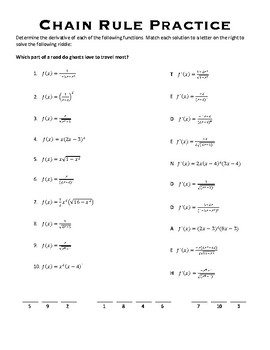. AP® is a trademark registered and owned by the College Board, which was not involved in the production of, and does not endorse, this site.® is a trademark registered. −3 1+9x2 Question 16 How many derivatives can you take of a function? Until you can no longer derive it Question 17 Let y=4sin(3x). Most mathematicians and historians agree that calculus was developed independently by the Englishman Isaac Newton (1643–1727) and the German Gottfried Leibniz (1646–1716), whose images appear in. When we credit Newton and Leibniz with developing calculus, we are really referring to the fact that Newton and Leibniz were the first to. ©n v2o0 x1K3T HKMurt8a W oS Bovf8t jwAaDr 2e i PL UL9C 1.y s wA3l ul Q nrki Sgxh OtQsN or jePsAe0r Fv le Sdh. J k JM 6a 7dXem pw Ri StXhA oI 8nMfpi jn EiUtwer 8CKahl 5c wuTl5u0s u. Vmware fusion 11 download macdownzup iso. 7 Worksheet by Kuta Software LLC.
Consider the product of two simple functions, say$ds f(x)=(x^2+1)(x^3-3x)$. An obvious guess for the derivative of $f$ isthe product of the derivatives of the constituent functions:$ds (2x)(3x^2-3)=6x^3-6x$. Is this correct? We can easily check, byrewriting $f$ and doing the calculation in a way that is known towork. First, $ds f(x)=x^5-3x^3+x^3-3x=x^5-2x^3-3x$, and then$ds f'(x)=5x^4-6x^2-3$. Not even close! What went 'wrong'? Well,nothing really, except the guess was wrong.
So the derivative of $f(x)g(x)$ is NOT as simple as$f'(x)g'(x)$. Surely there is some rule for such a situation? Thereis, and it is instructive to 'discover' it by trying to do thegeneral calculation even without knowing the answer in advance.$$eqalign{{dover dx}(&f(x)g(x)) = lim_{Delta x to0} {f(x+Delta x)g(x+Delta x) - f(x)g(x)over Delta x}cr&=lim_{Delta x to0} {f(x+Delta x)g(x+Delta x)-f(x+Delta x)g(x) + f(x+Delta x)g(x)- f(x)g(x)over Delta x}cr &=lim_{Delta x to0} {f(x+Delta x)g(x+Delta x)-f(x+Delta x)g(x)over Delta x} + lim_{Delta x to0} {f(x+Delta x)g(x)- f(x)g(x)over Delta x}cr &=lim_{Delta x to0} f(x+Delta x){ g(x+Delta x)-g(x)over Delta x} + lim_{Delta x to0} {f(x+Delta x)- f(x)over Delta x}g(x)cr &=f(x)g'(x) + f'(x)g(x)cr}$$A couple of items here need discussion. First, we used a standardtrick, 'add and subtract the same thing', to transform what we hadinto a more useful form. After some rewriting, we realize that we havetwo limits that produce $f'(x)$ and $g'(x)$. Of course, $f'(x)$ and$g'(x)$ must actually exist for this to make sense.We also replaced$ds lim_{Delta xto0}f(x+Delta x)$ with $f(x)$—why is this justified?
What we really need to know here is that $ds lim_{Delta xto 0}f(x+Delta x)=f(x)$, or in the language ofsection 2.5, that $f$ is continuousat $x$. We already know that $f'(x)$ exists (or the whole approach,writing the derivative of $fg$ in terms of $f'$ and $g'$, doesn't makesense). This turns out to imply that $f$ is continuous as well. Here'swhy:$$eqalign{lim_{Delta xto 0} f(x+Delta x) &= lim_{Delta xto 0} (f(x+Deltax) -f(x) + f(x))cr&= lim_{Delta xto 0} {f(x+Delta x) -f(x)over Delta x}Delta x +lim_{Delta xto 0} f(x)cr&=f'(x)cdot 0 + f(x) = f(x)cr}$$
To summarize: the product rule says that$${dover dx}(f(x)g(x)) = f(x)g'(x) + f'(x)g(x).$$
Returning to the example we started with, let $ds f(x)=(x^2+1)(x^3-3x)$.Then $ds f'(x)=(x^2+1)(3x^2-3)+(2x)(x^3-3x)=3x^4-3x^2+3x^2-3+2x^4-6x^2=5x^4-6x^2-3$, as before. In this case it is probably simpler tomultiply $f(x)$ out first, then compute the derivative; here's anexample for which we really need the product rule.

Example 3.3.1 Compute the derivative of $ds f(x)=x^2sqrt{625-x^2}$. We havealready computed $ds {dover dx}sqrt{625-x^2}={-xoversqrt{625-x^2}}$. Now$$f'(x)=x^2{-xoversqrt{625-x^2}}+2xsqrt{625-x^2}={-x^3+2x(625-x^2)over sqrt{625-x^2}}={-3x^3+1250xover sqrt{625-x^2}}.$$
Exercises 3.3
In 1–4, find the derivatives of the functions using the product rule.
Game 26: november 14 2014 the initials game show. Ex 3.3.1$ds x^3(x^3-5x+10)$(answer)
Ex 3.3.2$ds (x^2+5x-3)(x^5-6x^3+3x^2-7x+1)$(answer)
Ex 3.3.3$ds sqrt{x}sqrt{625-x^2}$(answer)
Ex 3.3.4$displaystyle {sqrt{625-x^2}over x^{20}}$(answer)

Ex 3.3.5Use the product rule to compute the derivative of $ds f(x)=(2x-3)^2$. Sketch the function. Find an equation of the tangent line to the curve at $x=2$. Sketch the tangent line at $x=2$.(answer)


Ex 3.3.6Suppose that $f$, $g$, and $h$ are differentiable functions.Show that $(fgh)'(x) = f'(x) g(x)h(x) + f(x)g'(x) h(x) + f(x) g(x)h'(x)$.

Ex 3.3.7State and prove a rule to compute $(fghi)'(x)$, similar to the rule in the previous problem.
3.1 Product Ruleap Calculus 14th Edition
Remark 3.3.2 {Product notation}Suppose $ds f_1 , f_2 , ldots f_n$ are functions.The product of all these functions can be written$$ prod _{k=1 } ^n f_k.$$This is similar to the use of $ds sum$ to denote a sum.For example,$$prod _{k=1 } ^5 f_k =f_1 f_2 f_3 f_4 f_5$$and$$prod _ {k=1 } ^n k = 1cdot 2 cdot ldots cdot n = n!.$$We sometimes use somewhat more complicated conditions; for example$$prod _{k=1 , kneq j } ^n f_k$$denotes the product of $ds f_1$ through $ds f_n$ except for $ds f_j$.For example, $$prod _{k=1 , kneq 4} ^5 x^k = xcdot x^2 cdot x^3 cdot x^5 =x^{11}.$$
3.1 Product Ruleap Calculus Calculator
Ex 3.3.8The generalized product rule says that if $ds f_1 , f_2 ,ldots ,f_n$ are differentiable functions at $x$ then$${dover dx}prod _{k=1 } ^n f_k(x) = sum _{j=1 } ^n left(f'_j (x) prod _{k=1 , kneq j} ^n f_k (x)right).$$Verify that this is the same as your answer to the previous problemwhen $n=4$,and write out what this says when $n=5$.
 DriveNime adalah tempat khusus untuk mendownload anime batch subtitle indonesia Di Google Drive dengan kualitas HD BD.mkv 1080p, 720p, 480p dan karena Drivenime mempunyai kualitas tinggi maka website ini cocok bagi Para Kolektor!
DriveNime adalah tempat khusus untuk mendownload anime batch subtitle indonesia Di Google Drive dengan kualitas HD BD.mkv 1080p, 720p, 480p dan karena Drivenime mempunyai kualitas tinggi maka website ini cocok bagi Para Kolektor!